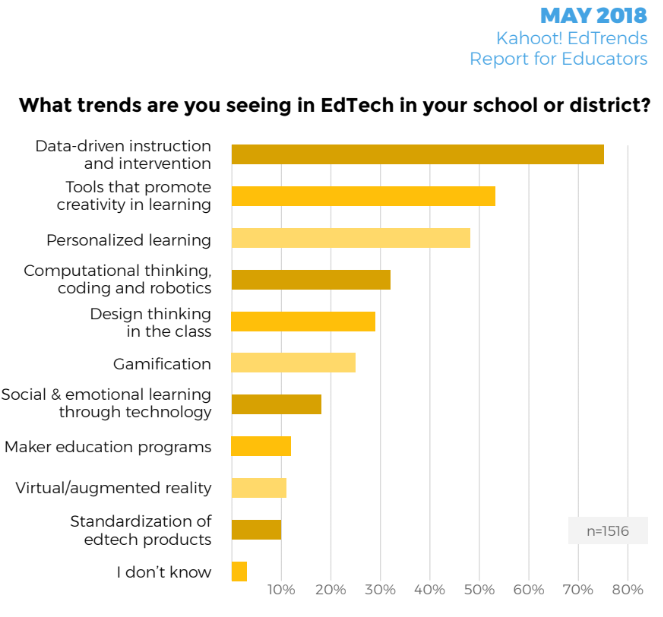Are You Meeting The Needs Of Your School? Quick-Checks And Surveys Can Help
Students are not the only ones who can benefit from survey results; Every stakeholder involved with the school can benefit from survey results. There are two things schools should look at, first what are the stakeholder’s thoughts, ideas, opinions, and usage of the tool or materials, and second, what does the back-end data suggest. This is a great starting point to see if funding needs to be re-allocated for other items, re-purposed to scale back, or eradicated to discontinue services. One added service we conduct at Educational Innovation 360 is a 360 degrees audit of schools with an initial survey. We take a look at various services, subscriptions, resources, and materials and identify their usages. Last year, we worked with a school and identified that there were over 43 subscriptions to various websites, vendors, and services that teachers barely used. Although when surveyed, teachers would say, “Oh, I use that every day” but on the backend, a teacher may have logged on 4 times throughout the school year.
Do Not Cut Back on Professional Development
We are now in a time where many financial resources are strained and schools are cutting back on things that matter. When Ei360 comes in and asked why they chose to cut down on professional development, the statement is “limited budges” or “we re-allocated the funds”. We know, teacher practice and training are the number one way to expedite student growth and although teachers can train each other, it still helps to bring in an outside source to helps schools transform.
Creativity is necessary when it comes to finding funding and resources. Of course, we can seek out grants and apply for funding in specific content areas but what I’m referring to is a little unique. We rarely turn to our community, businesses, and colleges most of whom will most likely take on community schools as a valued partnership. These ideas are real resources that stakeholders can use to co-collaborate programs, design internships, or find teacher content mentorship in their various fields of study.
How Can School Become Proactive: Recruitment and Retention
In working with a school in Texas, administrators assumed that they would lose half of their teachers due to Covid19, so in order to be pro-active we created a teachers aide pipeline, who would work as aids, but through an emergency certificate program could qualify to substitute. They were included in all of our professional development and through (TPA) Teacher Performance Assessment we helped them get certified. This is just one way but schools are working hard to overcome their concerns revolving around retention and funding hurdles. Using surveys has helped our organization match thoughts, ideas, and opinions, up with data to help schools identify items that really matter. On a basic level schools and districts are implementing surveys so they can understand how their teachers' views of teaching align with a new program or educational framework that a school is adopting.
Surveys To Identify Needs
Surveys also work when identifying needed resources that are interdepartmental as well. Two years ago, when a new educational frame-work program was introduced to a school, the department surveyed every teacher and had them answer a series of questions that identified the most important views of that teacher. The survey calculated how much each teacher's educational goals fit in with the new program.
What happens when funding is paired with a school’s wants and needs?
There are times when district leaders, programs, and school administrators dictate the terms. In this example, program and funding are tied to schools that have a similar focus prior to implementation. First, a survey is designed and delivered; after completing the survey, if the teacher's answers to the survey do not fit within those goals of the program, they will not be part of the program and will not receive additional funding. Although this funding allocation method is not without its complaints, the survey helps the district find teachers who will fit into the program. At the end of the year, the program's data is given to State officials to see how well a district performed. Since the teachers are tailor-made for the program, many of the data come back positive, and schools receive an adequate amount of funding for their programs for the next one or two years (Governing). This is not a traditional model but it targets schools that have a focus that is in-line with the program goals.
References
Hoff, David J. “Math and Science Could Be Big Losers Under New Law.” Education Week, 23 Feb. 2019, www.edweek.org/education/math-and-science-could-be-big-losers-under-new-law/2002/01.
Editor, M., Molnar, M., Editor, A., Michele Molnar Associate Editor Michele Molnar is associate editor of EdWeek Market Brief. She began working as a contributing writer for Education Week in 2012, Michele Molnar is associate editor of EdWeek Market Brief. She began working as a contributing writer for Education Week in 2012, & Says:, S. (2018, May 24). Data-Driven Instruction: Top Trend in K-12 Use of Ed-Tech, Teachers Say. Retrieved January 29, 2021, from https://marketbrief.edweek.org/marketplace-k-12/data-driven-instruction-top-trend-k-12-use-ed-tech-teachers-say/
Governing. Education Spending Per Student by State, www.governing.com/archive/state-education-spending-per-pupil-data.html.

